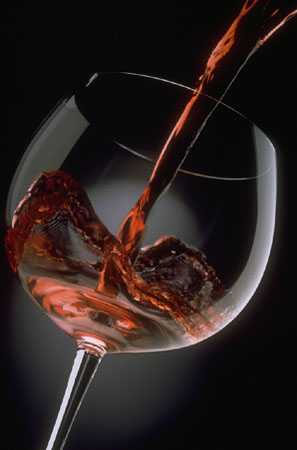Tasting wine properly is straight forward enough, all you need to do is make sure that you don't dribble while slurping, and that you have confidence in your analytical abilities. Learning the different flavors and aromas will develop with time, so try lots of different wines, read the tasting notes on the back label, and go for it!
Before you can taste anything, you need to first open the bottle with the best wine bottle opener you can afford. For a modest budget I recommend the Screwpull Table Model.
There are so many good ones to choose from. See Wine Accessories...
Appraising the Wine

This is where you have to look for those wine adjectives to describe what you taste.
When assessing or appraising a wine we use four of our five senses:
- Vision (sight)
- Olfaction (smell)
- Degustation (taste)
- Tactile (feel)
Sight
You make two judgements when you look at a wine.- One is the color, both the hue (the color of the horizon of the wine) and the intensity. The other is its appearance. From this it is possible to make some judgements about the condition and the age of the wine. The colors of a white wine may be water white, yellow, gold, straw yellow, amber, brown, golden yellow, pale gold or other. Aged white wines will have typically deeper yellows and golds. Red wines may be pink, orange, light red, tile red, brick red, ripe plum and many other descriptions. Ageing will show orange and browns.
- The wine clarity is essentially how clear the wine is (brilliant, clear, transparent, cloudy, dull, hazy, turbid or other). Naturally the wine should be clear and brilliant.
Smell
The smell of the wine can be divided into its aroma, grape derived odors, and the bouquet, odors derived from the winemaking process.
During the fermentation of the grape many chemical compounds are made which produce odors that can be recognized and described, eg. apple, melon, blackcurrant, blackberry, licorice etc. The maturation of the wine in oak may also add to the smell of the wine through vanilla, caramel and creamy type smells. The list of perceived smells is endless and unfortunately not all are pleasant. Good winemaking endeavours to avoid those unpleasant odors like mousse, foxy or musty type odors
Taste and Tactile sense
Of the four primary tastes three are predominant in wine tasting: sweetness, acidity and bitterness.
Associated with the sense of taste is the feeling produced in the mouth. Alcohol in moderate concentrations can be perceived as sweet. High alcohol wines may produce a warm or hot sensation. Dissolved carbon dioxide can be felt as a fizz or spritz, and astringent wines can cause dryness or puckering in the mouth. Wines high in glycerol appear viscous and give a fatter or thicker feel in the mouth.
All of these sensations will lead to the overall mouth feel. A balanced wine is one without holes or gaps where all the components fill the mouth with a uniform smooth enjoyable feeling. Balance is what the winemaker strives to achieve.
We are now ready to taste the wine.
 How To Taste Wine Properly
How To Taste Wine Properly
- To appraise the wine, the glass should be clear and one third full.
- Tilt the glass on a 45-degree angle away from you with a white background so the visual assessment can be made.
- Swirl the wine in the glass several times so the volatile chemicals, those that give rise to the wine's aroma and bouquet, can collect in the glass.
- Smell the wine with 2-3 full quick sniffs. If you continually sniff the wine the smells will become confused. Most people can only detect 3-4 different smells at one time.
- Make a written or mental note of the smells and your assessment.
- Now take a generous mouthful, suck air through the wine (try not to dribble), swirl it around the mouth so as to cover the mouth with the wine, spit out the wine and record your impressions - (at a formal tasting, a spittoon will be provided).
- Predominant tastes and odors are best detected with the mouth empty as the volatile chemicals will rise through the retronasal passage. As the wine warms when swallowed vapors will rise up through to the nose, for further smell detection. Many perceived tastes are indeed a smell. Try to taste the same wine while holding your nose closed and you will find the tastes you were able to detect difficult to find.
Oz Clarke's How to Taste Wine
How To Become A Wine Tasting Expert
It's always hard to spit out wine, but constant tasting would have you under the table in no time!
The Home Winemaker's Inner CircleIn the NEXT 6 minutes, YOU can start making your own delicious wine from the comfort of your own home! How to Make Wine! |

|
|---|---|
Fool-proof Wine Values“If you're regularly in the market for good, inexpensive wines, I think you'll find Ed Gandia's e-book will pay for itself in your next few visits to the wine shop.”
|

|
Successful Winemaking - Craft Superb Table Wines At HomeHow to Craft Superb Table Wines at Home
|

|
2basnobs Wine Tasting KitLearn the Secret to Really Tasting Wine and See What You've Been Missing!
|

|






